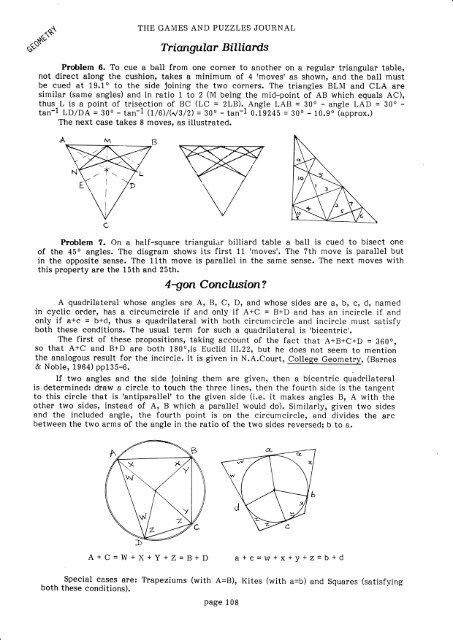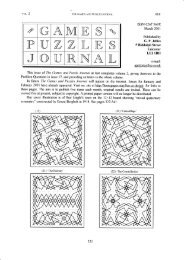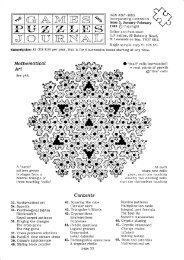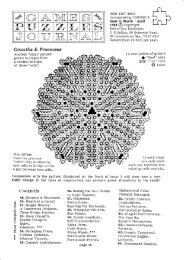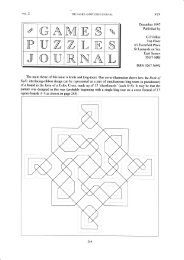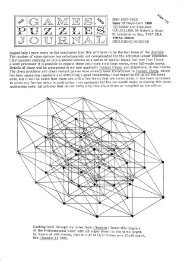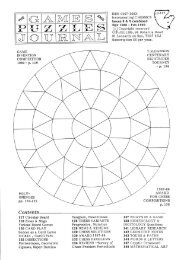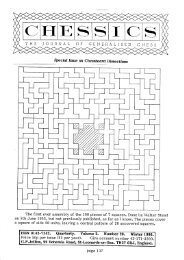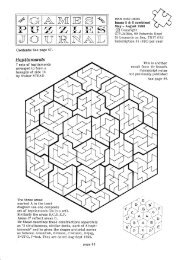The Games and Puzzles Journal, #7 - Mayhematics
The Games and Puzzles Journal, #7 - Mayhematics
The Games and Puzzles Journal, #7 - Mayhematics
Create successful ePaper yourself
Turn your PDF publications into a flip-book with our unique Google optimized e-Paper software.
.^$\,c$v't&"'THE GAI'4ES AI.ID PTJZZLES JOURNALTri,angvlar BillionlsProblem 6. To cue a ball from one corner to another on a regular triangular table,not direct along the cushion, taftes a minimum of 4 rmoves' as shown, <strong>and</strong> the ball mustbe cued at 19.10 to the side Joining the two corners. <strong>The</strong> triangles BLM <strong>and</strong> CLA aresimilar (same angles) <strong>and</strong> in ratio l" to 2 (M being the mid-point of AB which equals AC),thus.L is a point of trisection of BC (LC = 2LB).,AngIe LAB = 30o - angle LAD = 30o -tan-I LD/DA = 30o - tan-1 (r/6)/(49/2) = 30o - tan-1 o.Igz+s = B0o - 10.9o (approx.)<strong>The</strong> next case takes 8 moves, as illustrated.AE\- \*--./l\Problem ?. On a half-square triangui;r billiard table a ball is cued to bisect oneof the 45o angles. <strong>The</strong> diagram shows its first 11 tmovest. <strong>The</strong> ?th move is parallel butin the opposite sense. <strong>The</strong> llth move is parallel in the same sense. <strong>The</strong> next moves withthis property are the 15th <strong>and</strong> 25th.4aon Concluston?A quadrilateral whose angles are A, B, C, D, <strong>and</strong> whose sides are a, b, c, d, namedin cyclic order, has a circumcircle if <strong>and</strong> only if A+C = B+D <strong>and</strong> has an incircle if <strong>and</strong>only if a*c = b+dr thus a quadrilateral with both circumcircle <strong>and</strong> incircle must satisfyboth these conditions. <strong>The</strong> usual term for such a quadrilateral is tbicentric'.<strong>The</strong> first of these oropositions, taking account of the fact that A+B+C+D = 3600rso that A+C <strong>and</strong> B+D are both 180o,is Euclid IIl.22, but he does not seem to mentionthe analogous result for the incircle. It is given in N.A.Court, College Geometry, (Barnes& Noble, 1964) ppl35-6.If two angles <strong>and</strong> the side Joining them are given, then a bicentric quadrilateralis determined: draw a circle to touch the three lines, then the fourth side is the tangentto this circle that is 'antiparallel' to the given side (i.e. it makes angles B, A with theother two sides, instead of A, B which a parallel would do). Similarly, given two sides<strong>and</strong> the included angle, the fourth point is on the circumcircle, <strong>and</strong> divides the arcbetween the two arms of the angle in the ratio of the two sides reversed; b to a.A + C = W + x + Y + z = B + Da + C = tV + X + y + Z = b + dSpecial cases are: Trapeziums (with A=B), Kites (with a=b) <strong>and</strong> Squares (satisfyingboth these conditions).page 1 08


